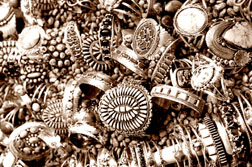|
observer |
|
|
|
|
|
OTHER LINKS |

|

|

|
Body jewellery and piercing will never dieYou might think that body jewellery is a new phenomenon, but the reality is that body jewellery has been worn in one form or another for almost 30,000 years. It's certainly true that the techniques used and the materials available have undergone significant changes through the centuries, but the idea remains the same.
Among teenagers, body jewellery for tongues, noses, lips and eyebrows are the most frequently sought after and purchased items. And then there is quite a variety of body jewellery for the more intimate parts of the body. The number and type of items available is constantly changing. Given the new composite materials being developed currently which are usable for body jewellery, it seems unlikely that the body jewellery industry will experience any decline in popularity. Still, the two most common materials used in body jewellery are stainless steel and titanium. Stainless steels are generally classed into four generic categories, based on their composition. Not all are truly suitable for making body jewellery. The 200 series stainless steel contains chromium, nickel and manganese. The 300 series contains chromium and nickel. The 400 series contains chromium and the 500 series contains low chromium. The most commonly used stainless steels for body jewellery corrosion are those in the 300 series, because of their resistance to corrosion.
Most stainless steel body jewellery items are electro-polished. This is a reasonably sophisticated surface finishing technique which leaves the finished surface very smooth and free of any crevices or fissures. The result is a significantly higher surface integrity which is ideal for body jewellery. Alternatively, titanium has recently become very popular as a material for body jewellery. In fact, it is challenging stainless steel as the favoured metal. The main reason for the increasing favour shown titanium is that titanium body jewellery items are about half the weight of equivalent stainless steel items. In addition, titanium can be anodized and this creates a marvellous variety of colours when contrasted with the single option of stainless steel's silver appearance. Not only pretty - or attractively masculine (depending on who you are) - the oxide layer on titanium also is highly resistant to corrosion. So, if you're looking to get a piercing (of whatever sort), you are joini ng a historically honoured trend going back thousands of years and today you'll find a much safer and more attractive mix of items suitable for the most conservative to the most radical devotee of piercing and body jewellery. |
 What you'll find is that most people these days are using some form
of body jewellery. No doubt earrings, technically a form of body
jewellery, are one of the most common items, but ultimately many
different types of body jewellery are worn in piercings and in almost
any place you can imagine, and maybe a few you'd never dream of.
What you'll find is that most people these days are using some form
of body jewellery. No doubt earrings, technically a form of body
jewellery, are one of the most common items, but ultimately many
different types of body jewellery are worn in piercings and in almost
any place you can imagine, and maybe a few you'd never dream of. 
 Although the stainless steels used contain some nickel, they don't
release nickel salts into the body, and therefore are highly unlikely to
lead to nickel contact dermatitis.
Although the stainless steels used contain some nickel, they don't
release nickel salts into the body, and therefore are highly unlikely to
lead to nickel contact dermatitis. 






